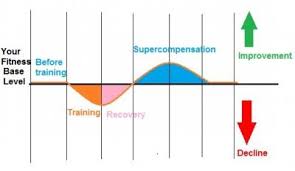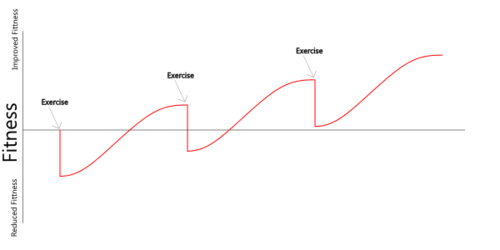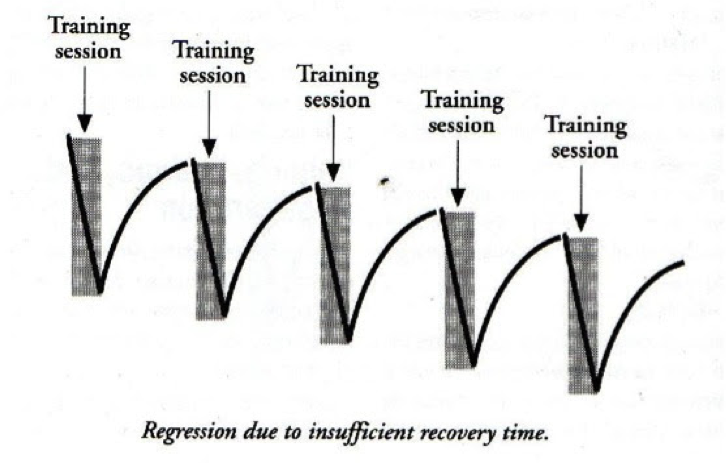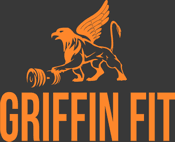The Supercompensation Curve
by Tia Dewick in Training

The supercompensation curve is a scientific theory which demonstrates the process of bodily adaption to progressive exercise programmes. This theory takes into account your initial fitness, your exercise, your recovery and your adaptation. In a nutshell this means that at the start of a resistance programme you may be able to bicep curl 2kgs for 8 reps (ie initial fitness) but by incorporating variations in your programme to vary your training (ie your exercise) with 2-4 days of rest per week (ie recovery), by week 4 you may be able to bicep curl 4kgs for 12 reps (ie your adaptation).
The supercompensation curve is demonstrated below.

As you can see in the graph above, the first straight line represents your initial fitness level. Then as soon as you undertake exercise, your muscle fibres undergo small tears which results in a short term reduction in muscle performance (for example at the start of a session you may easily be able to achieve 12 reps of bicep curls with 4kg but by the end of it you may even struggle to pick up 2kg if you’ve worked hard). Therefore, this results in your muscles temporarily dropping below your baseline level as shown on the graph above. Following your training session you undergo a recovery period whereby your muscles have chance to rebuild and adapt to the stimuli of your training session to exceed above your baseline level. As long as you provide your muscles with plenty of recovery time, your progress will look like the graph shown below.

HOWEVER, if you repeat your next bout of exercise before your muscles have chance to adapt above your initial performance, as the muscle is still fatigued and breaks down further as a result of your next bout of exercise, this may result in your muscles regressing as opposed to progressing over time as demonstrated by the graph below.

Alternatively, to optimise your adaptation/supercompensation here are some key factors to help measure and enhance your adaptation.
Initial fitness
To identify your baseline muscular performance you need to perform an exercise relevant to the muscle groups that you wish to measure. Sticking with my bicep curls example, if you want to measure the progress of your biceps, see how many reps of bicep curls you can achieve with a realistic weight until fatigue.
Exercise
Before your exercise session you need to properly fuel your body to get the best out of our session. This could include the intake of caffeine (can be found in a cup of coffee) to help increase your energy by making free fats available in the blood stream. Consuming a high carbohydrate meal (ie pasta) 4 hours before followed by a carbohydrate snack (ie a banana) 1 hour before will provide you with the optimal carbohydrate energy availability. Be sure to also consume plenty of water! Some theories suggest that you may need to overhydrate yourself prior to your exercise to ensure there is sufficient availability if you cannot replace the water as fast as you use it.
For the exercise itself EVERY session you need to do something slightly differently whether this be by increasing the weight or increasing the reps or using variations in exercise techniques such as changing the tempo (ie one day aim for fast reps and another day aim for slow and controlled reps) or using isometric holds at the start or end of a movement or utilise incremental movement patterns (ie do 4 reps of the full bicep curl, 4 reps half way and 4 small reps).
Recovery
Nutrition is another way to maximise your recovery so be sure to consume at least 20 grams of protein after your workout whilst also trying to consume at least 20 grams of protein 3-6 times a day in addition to refuelling your fats and carbs. The volume of your macronutrients needed depends on the workout type (such as cardio or resistance).
Overtraining can hinder your progress! The optimal training pattern is 3-4 times a week with rest on the remaining days. Unless you allow your muscles time to recover, you may regress as opposed to progress so make sure you are looking after your body.
Adaptation
The more of the factors above that you have optimally achieved, the better your adaptation will be. To identify your progress, now retry your baseline activity. So if you tested how many bicep curls you could do with 4kg, see how many you can do now or see is you can now do the same amount of reps with a higher weight. If you beat your initial score, whoop whoop you’ve made supercompensation progress!
Don’t forget to follow us on our social media platforms for regular blog notifications and plenty of workout routines.
